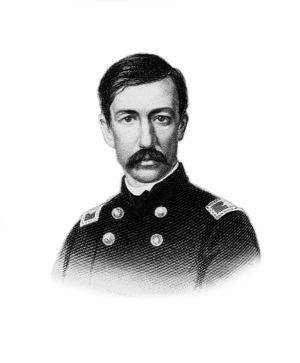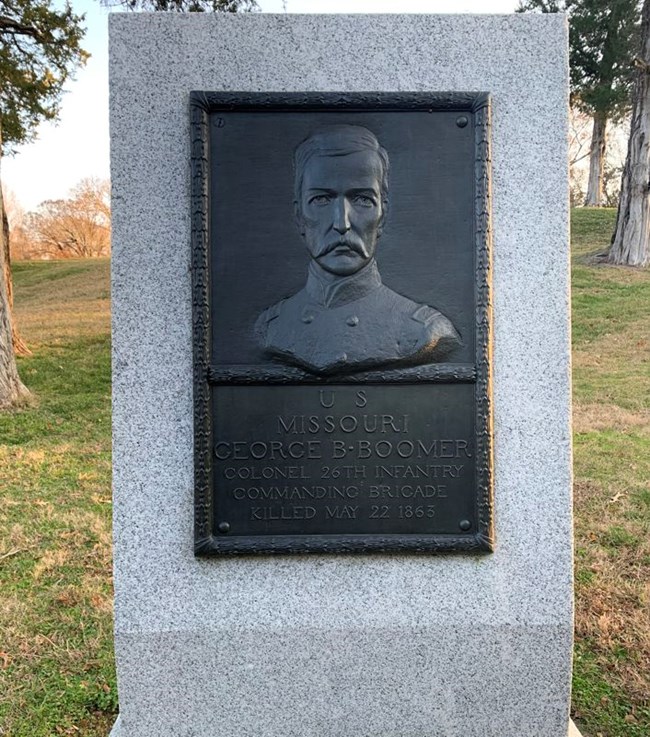
Memoir of George Boardman Boomer (Public Domain) On the night of April 16, 1863, Colonel Boomer watched the navy boats run the batteries in front of Vicksburg, writing to his sister: "It was the most magnificent sight I ever saw..." (Memoir, 248). Crossing the Mississippi River with his brigade, Boomer's men participated in the final portions of the Battle of Port Gibson on May 1, 1863, and actions the following day. The young colonel knew he was taking part in something special pointing out to his sister that: "Since General Grant commenced to move his columns he has displayed great tact and skill, together with immense energy and nerve. The passage of this army over the Mississippi River and up to this point is one of most masterly movements known in the history of any warfare, and it is a success" (Memoir, 250). Colonel Boomer's men were in reserve during the Battle of Raymond (May 12), led the march and participated in the Battle of Jackson (May 14), and at Champion Hill (May 16), held a critical part of the northern Union lines, stemming a Confederate counterattack on Champion Hill. Boomer was cited for his gallant actions during the battle in reports. Arriving in front of the Confederate defenses blocking the railroad bridge at Big Black River, Boomer's brigade marched and countermarched in support of the assaulting troops, though Boomer admitted, "...his (the Confederate) force was completely routed by the time I got on the ground..." and his men wrapped up the action, capturing Georgia and Arkansas troops. Marching on Vicksburg, Boomer and his brigade arrived on May 18, settling in on the left flank of the 17th Army Corps. On May 22, 1863, Grant's army began their assaults along the entire Confederate fortification line at 10AM. Boomer's brigade formed in line on the right of John Sanborn's brigade, both moving to a ridge 300 yards from the Confederate fortifications held by John C. Moore's brigade. Boomer observed the obstructions of felled trees the rebels had left in the ravine between his brigade and the fortifications. Though reinforced, Boomer stalled assaulting Moore's position. In the afternoon, Major General John A. McClernand requested reinforcements to press his advantages on the Union left flank, and Isaac Quinby's division (including Boomer's brigade) moved in a roundabout fashion two miles south to help. Ordered to assault the rebel fortifications north of railroad tracks, Boomer formed his men into two assaulting column in the hollow and, while realizing the futility of his orders, received a fatal wound to the head. His brigade remained in the ravine until dark when it pulled back to safety. Colonel Boomer was initially buried at Young's Point, Louisiana, before he remains were brought up to his adopted home of St. Louis, Missouri in June. Finally, Boomer's remains arrived at his father's home, in Worcester, Massachusetts, where he was buried. Of the many testimonials written about George Boomer's death, perhaps one of the most sincere was written by Assistant Secretary of War, Charles A. Dana: "I have met with few person in life for whom I have felt such an instinctive sympathy as Boomer. He was brave, manly, affectionate, and sincere, keen in perception and sound in judgment. Of the many good soldiers who have fallen in this magnificent campaign, his death is the only one which has caused me direct personal sorrow" (Memoir, 274). Boomer was posthumously promoted to Brigadier General for his actions during the Vicksburg campaign. 
NPS Photo Colonel, 26th Missouri Infantry.Commanding the Third Brigade, Seventh Division, Seventeenth Army Corps, April 22 - May 22, 1863.Cost: $275 for bronze, paid for by the Federal government. Sculptor: T.A.R. Kitson Erected: April 1911 Location: Union Avenue, 200 yards north of the Minnesota State Memorial. 
NPS Photo |
Last updated: December 21, 2019
